Case Study #1: How I'd position and grow Docuchat

Created by Denizcan Sanlav
Introduction:
Case study’s purpose:
This case study presents hypotheses on how to increase the revenue and conversion rate of the Docuchat product.
The hypotheses in this case study offer a framework for product positioning, landing page copywriting/messaging, and pricing strategies.
Case study’s format:
With this case study, you will learn how to market your products. Each section is interconnected, and reading them in order will be more beneficial.
Here are the frameworks we will discuss in the hypothesis I call the “irrational model”:
- – Creating a non-competitive niche
- – Understanding what your customers want and creating emotional resonance in landing page
- – Convincing potential customers to buy using cognitive biases
- – Designing irrational pricing
I work on product, marketing, and behavioral psychology. In the idea phase, I see the whole process from beginning to end.
I even imagine how the product will be marketed and its landing page design. I believe it’s not logical to create a product that cannot be marketed or doesn’t solve any problems.
Things like product positioning, target audience, unique value, pricing models, and landing page marketing dictate how the product should be.
Now I will do this for Docuchat.
What is Docuchat?

Docuchat is a chatbot service powered by GPT-3 that enables you to converse with your documents and receive instant responses.
Users upload their documents and create chatbots. The answers to the questions they ask their chatbots are extracted from the information in their documents and presented as responses.
This means that Docuchat provides instant access to information.
1. Docuchat’s positioning:
“If you chase two rabbits, you will not catch either one”
Problem / Diagnosis:
Docuchat has not been positioned clearly on its landing page. The page mainly focuses on the product’s features and what it does, but:
- The positioning is not clear.
- The target audience is not defined.
- The problem it solves (pain point) is not clear.
- The benefits are not addressed.
An unpositioned product’s target audience is everyone. And if you create something for everyone, you convince no one.
Insight: Docuchat is currently a macro product. If we do not niche it in different areas or contexts, it will be costly. We will never be able to explain the problem, pain points, and value we offer. If the positioning is not clear, we will face messaging problems on the landing page and fail to influence our target audience.
This will result in a poor conversion rate.
Solution / Hypothesis:

“The supreme art of war is to subdue the enemy without fighting.” – Sun Tzu
The most critical thing when positioning your products is to find/create a category where you can be number one. In every industry and niche, only a few top brands come to mind. The first three websites on Google take 90% of the traffic.
First, you must position your product in perception.
On the other hand, considering that hundreds of products are launched every day, you will be in constant competition. If you think of competing, I’m sorry, but you must be foolish. (Life is short.)
In a time where building is easier but marketing is harder, you need to find a solution to differentiate your product and avoid competition.
Docuchat for 4 Different Niches
Let’s position Docuchat for different niches. Here are 4 examples:
For companies;
Docuchat can create significant value for companies in their training or processes. It can automate processes with fewer employees and lower costs.
For audience builders;
Interacting with their audience requires serious time and effort for audience builders. People follow micro-influencers because they are interested in their thoughts on a specific subject, not someone else’s. Since the subject of the job is the audience builder themselves, delegating their work can be quite difficult. Docuchat could mean that audience builders can clone themselves.
For second brain builders;
I am one of them (especially with my Obsidian system). Second brain builders often have a huge note system. Docuchat can provide a solution for them to quickly talk with their notes.
Bonus;
We can position Docuchat to chat with the wisest people in history. From Vinci to Marcus Aurelius, Socrates to Einstein. To transform the wisdom of the most influential people in history into a chatbot and converse with them.
If I were to position Docuchat for these 4 niches, I would roughly write 4 different headlines as follows.

4 different headlines;
For Companies: Automate your employee training processes with your AI-powered chatbot.
For Audience Builders: Clone and scale yourself. Transform your wisdom into a powerful chatbot.
For Second Brain Builders: Talk with your notes by powering your second brain with AI.
For Others: Journey Through Time: Talk with the Greatest Minds in History!
Do you see the difference? The product is the same. However, the game changes depending on how we position it. The target audience, problems solved, and benefits offered are different for these four product examples.
For companies, Docuchat’s benefit is cost reduction. For audience builders, Docuchat’s benefit is scaling themselves (i.e., their income).
For second brain builders, Docuchat’s benefit is speed and efficiency. For others, Docuchat’s benefit is inspiration and entertainment.
Target audience, problem, benefit, and value. These work together.
For companies, Docuchat can make three employees unnecessary and generate $30k of value per month, for example.
For second brain builders, Docuchat provides faster access to their notes and increases efficiency, which saves them time. Measuring tangible value is more difficult.
To create a better landing page and conversion rate, our problem, benefit, value, and target audience must be clear.
Where will you find your target audience?
Since Docuchat has not yet been positioned, it means that the target audience is not clear. If your target audience is not clear, where do you look for potential customers? Unfortunately, there is no clear answer to this.
However, things become clearer when I position Docuchat for different niches, as shown above.
For example:
For companies; I use Apollo tool to list companies in a specific sector. I filter decision-makers in companies and verify their email addresses. Then, I do cold outreach to address the problems and pain points that Docuchat solves for companies.
For audience builders; I find people who do build in public. I go to subreddits, Indie Hacker. I find makers who use the build in public keyword on Twitter.
For second brain builders; I scrape Tiago Forte’s followers on Twitter and do cold outreach to them. Depending on the strategy, I can test this audience by targeting them with ads. Tiago Forte sells second brain education. His potential audience is second brain builders, which is also our target audience.
The above 4 positioning examples can be replicated. If it were me, I would productize each of them differently. However, for the continuation of this case study, I will proceed by positioning Docuchat for audience builders.
2. Limbic map – Understanding what your customers want and creating emotional resonance
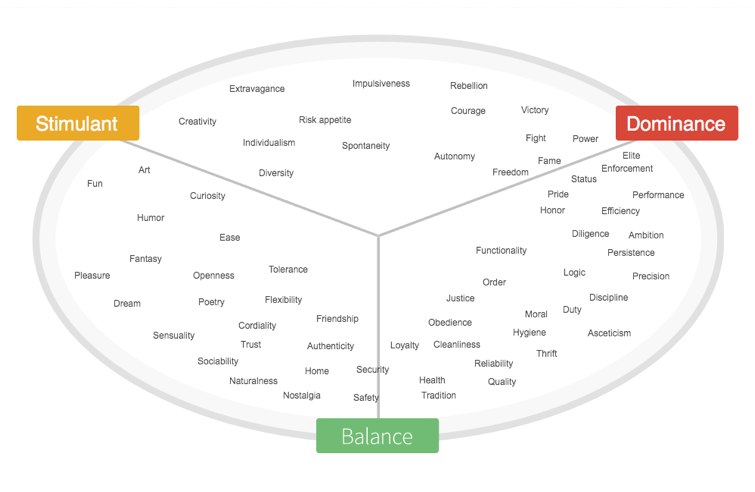
What drives people to take action are irrational, implicit (emotional) codes. Limbic map allows us to understand our customers’ basic motivations and what drives them to action.
It is an alternative and simple way to examine brain activities.
We need to find which emotional values our audience associates with our product, and create messaging on our landing page that creates emotional resonance to persuade potential customers.
For example, a performer personality type has a desire for power. To persuade them, we need to make them feel like we’re giving them power. Or a harmonizer personality type always has a need for security.
If your product doesn’t seem secure, it’s impossible to persuade them.
For instance, let’s persuade 7 different limbic personality types.
Docuchat headline for the 7 limbic personality types

Do you see the underlined keywords? Keywords target the emotional values of each limbic personality type.
Harmonizer: “Stay connected with your community like never before with Docuchat’s personal chatbot – bringing your wisdom to their fingertips.”
Open-minded: “Expand your community’s horizons with Docuchat’s AI-powered chatbot, sharing your unique knowledge and dreams with ease.”
Hedonist: “Experience the joy of effortless community-building with Docuchat’s fun and creative chatbot – no more time-consuming one-on-ones.”
Adventurer: “Ready for a new adventure in community building? Let Docuchat’s daring chatbot clone and scale your wisdom for you.”
Performer: “Elevate your community-building game with Docuchat’s high–performance chatbot – experience the power of scaling for more people .”
Disciplinarian:
“Maximize your efficiency and impact with Docuchat’s detail–oriented chatbot – perfect for the ambitious community builder.”
Traditionalist: “Ensure your community’s reliability and loyalty with Docuchat’s traditional and trustworthy chatbot”
Each color represents a different limbic personality type, and the emotional values of that personality type are found in that area of the map.
The emotional values of each limbic personality type are different, so we need to convey different messages to each one to influence them.
The product is the same, but it evokes different feelings and offers different benefits for each personality type.
These are emotional values, and if we can’t raise emotions, the potential customer won’t make the purchase.
Now I will match Docuchat with my own core values and design the landing page accordingly. (Let’s assume that the entire target audience is just me :)

Docuchat product makes me feel the emotional values of power, productivity, and performance.
We can see the distribution of these emotional values on the map as follows:
- The audience with these emotional values is in the Dominance area.
- And they represent the Performer limbic personality type.
If an audience’s emotional motivations are power, productivity, and performance, we can use these emotional values to persuade them.
Thinking about both the product positioning and the limbic personality type, I would write a headline like this:
Positioning: Audience builders
Limbic personality type: Performers

In the above image, some words are marked in green:
Clone, scale, powerful, transform
I would use these words to influence the performer personality type in the context of power and efficiency. Of course, this is a combination of the product, target audience, and value proposition. It emphasizes the benefits of Docuchat for audience builders and the performer personality type more clearly and smoothly than the current headline.
After positioning and emotional segmentation, let’s see how we can do landing page and copywriting using cognitive biases.
3. Persuade potential customers to purchase.
Behavior model and cognitive biases for landing page and copywriting.
In this section, we will highlight the value of the product on the landing page by using the behavioral model and cognitive biases in its sub-steps.
Fogg behavior model
There are many different methods in classical copywriting. The most common and my favorite method is “Problem, Agitation, Solution, Benefit”. However, from a behavioral psychology perspective, classical methods are insufficient.
Our main goal for the landing page is to achieve conversion. We want a potential customer who has not yet made a purchase to become a customer. This is a behavioral change.
For this, I am using BJ Fogg’s behavior model.
The Fogg behavior model consists of 3 steps:
- Motivation
- Ability
- Trigger / prompts
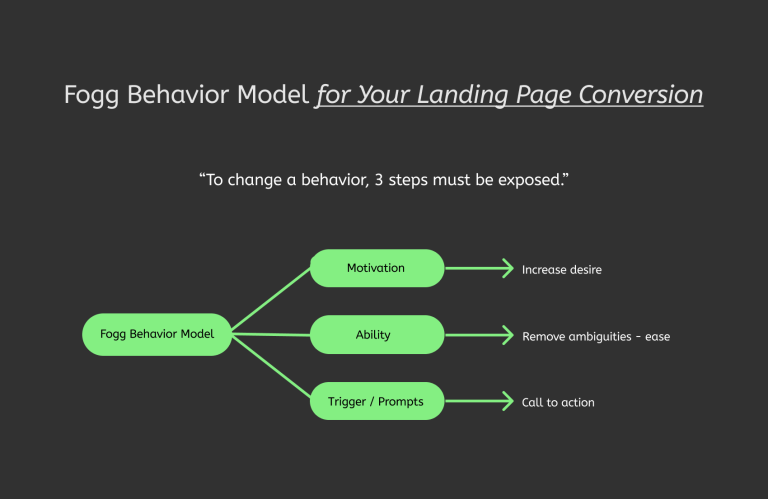
The Fogg behavior model consists of 3 steps: motivation, ability, and trigger/prompts, and all three steps must be present for a behavior change to occur.
Let’s think about a potential customer who visits your website.
– If they’re not motivated, they won’t make a purchase.
-If there are barriers to making a purchase, they won’t make a purchase.
-If they don’t take action, they won’t make a purchase.
Missing any one of these steps means that the person won’t become a customer. Now let’s look at how to use cognitive biases in these steps.
Cognitive biases
Cognitive biases are another key component of the irrational model I’ve designed. They are the shortcuts we use to make decisions (Kahneman’s System 1 theory). We unconsciously use cognitive biases to perceive, evaluate, and make decisions.
We make more than 70% of our daily decisions using System 1, meaning we think quickly. Cognitive biases can lead us to make mistakes because of this speed.
When explaining our product to potential customers and persuading them, we should make their cognitive processes and perceptions easier.
Motivation – Increase potential customers’ desires
Create contrast
Associated cognitive biases and effects; Contrast effect, framing effect.
What we compare something to and how we frame it affects our perception and decision-making.
For example:
- Comparing the features and benefits of a product to bad alternatives.
- Creating contrast in terms of time, effort, and money.
What bad alternatives do people use when they don’t have the product?
Docuchat’s landing page doesn’t create contrast. Here’s an example of contrast effect for Docuchat:


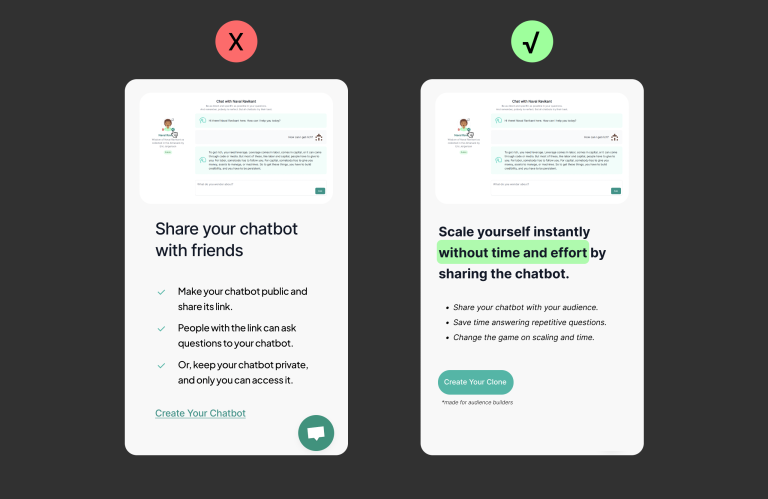
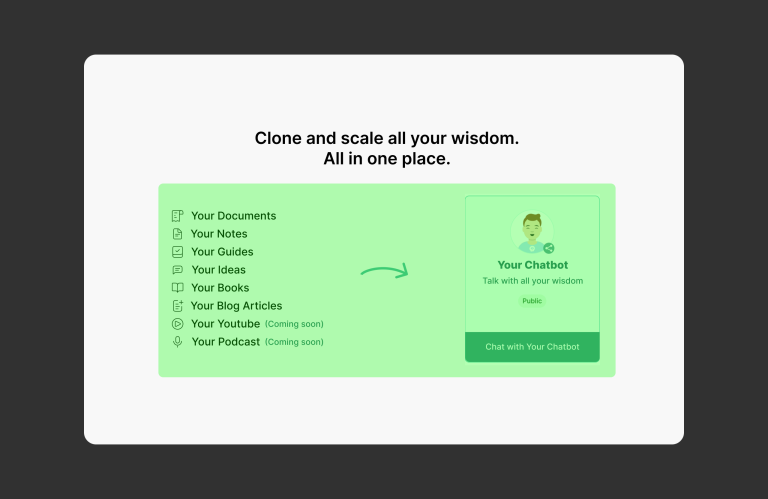

– Docuchat replaces manual workload.
-Docuchat allows me to do things that we would normally do with time and effort, without time and effort.
-Docuchat takes my place even when I’m not there.
-It makes independent things all in one place.
I created a contrast to highlight the benefits of Docuchat from different angles.
In particular, it is more effective to express them visually.
It’s about the way our mind perceives.
Emphasizing Immediate Benefits
Related cognitive biases and effects; hyperbolic discounting, present bias
Hyperbolic discounting and present bias are our tendency to prioritize immediate rewards over rewards that will come in the future, even if those immediate rewards are smaller.
If the benefits of your product only appear long after purchase, convincing potential customers can be quite difficult.
For example, selling products such as bodybuilding or language learning courses, where the benefits become apparent after a long time. However, we are not good at sustaining things and being patient.
Therefore, create immediate emotional or rational benefits that potential customers will experience when using your product. And emphasize this on your landing page.
Docuchat allows me to create an instant chatbot and get an instant response. However, these important benefits are not emphasized enough on the landing page.
Here’s how I did it for Docuchat.

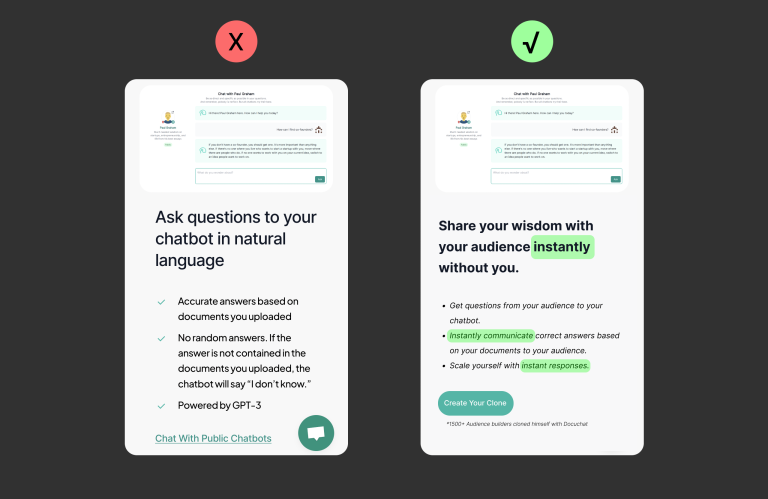
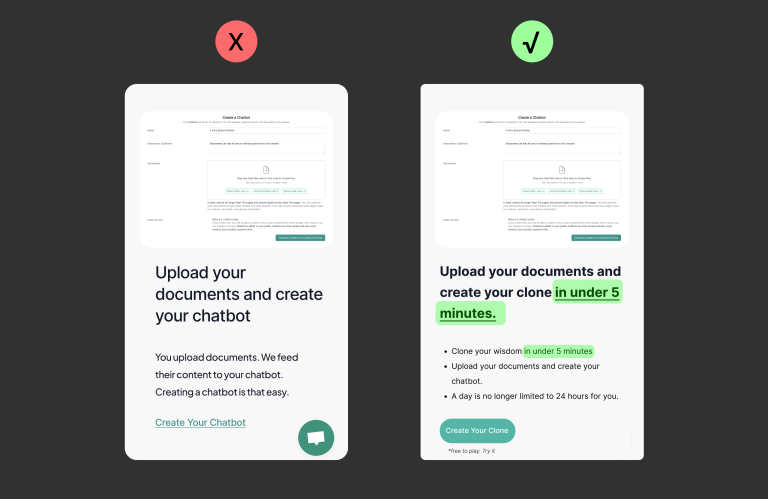
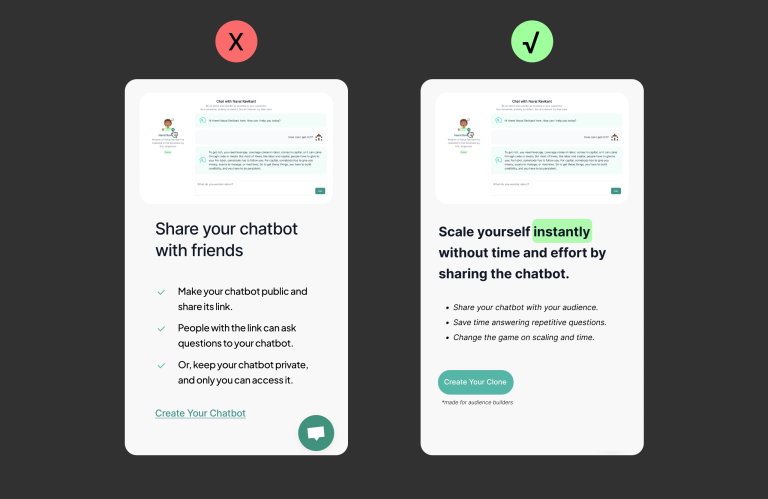
- Get instant answers with our personal chatbot – this is an immediate benefit.
- Create our personal chatbot in under 5 minutes, easily using our documents.
Yes, I know I can quickly create my own clone.
I also know that my questions will be answered instantly from the huge piles of information.
These are the aspects that we need to highlight and polish the product.
These are the benefits offered by Docuchat to its users. The words “clone” and “scale” also emphasize the benefits for our limbic type. We should consider not only rational, but also emotional benefits.
Highlight the Losses
Related cognitive biases and effects; Loss aversion.
The pain of losing $100 is twice as powerful as the pleasure of gaining $100. This was proven not by me, but by Daniel Kahneman.
Winning something means getting more than what we currently have. However, losing means a reduction of something that we already have.
Therefore, losses always have a greater impact than gains because we always tend to act in order to protect our current situation.
Docuchat’s landing page doesn’t convey the feeling of what we would lose if we don’t use the product. To emphasize the losses and agitate the situation,
I would design a section on Docuchat’s landing page that highlights the losses.

Docuchat eliminates the need for manual workload that require time and effort.
The above section triggers both contrast and avoidance of loss. If you continue to do this manually instead of using Docuchat, you will lose these benefits. It is important to make abstract things concrete, such as hours and costs.
Lastly, I emphasize the comparison made with contrast, rationalizing the loss.
Ability – Remove barriers to purchase
Remove all barriers to purchase for a potential customer. Everything.
Remove Ambiguity
Related cognitive biases and effects; Ambiguity effect, zero bias effect.
The brain loves clarity and hates uncertainty.
When choosing between two options, we tend not to choose the option that contains uncertainty.
This applies when marketing our products as well. List anything that could create uncertainty for a potential customer.
Here’s how it applies to Docuchat:

The purpose of a button is to trigger an action. And I can emphasize that starting below the button is free.
This eliminates any ambiguity and removes a barrier to taking action.
Alternatively, I could use the phrase “no credit card required.”

I have a clear positioning for the product. I positioned it for audience builders. I will add this section towards the end of the landing page (but before pricing).
I help audience builders clarify their thinking if they have read up to this point. This is also known as “confirmation bias.”
A potential customer who has been convinced up to this point will look for details that confirm their idea. I help them validate and clarify their thinking.
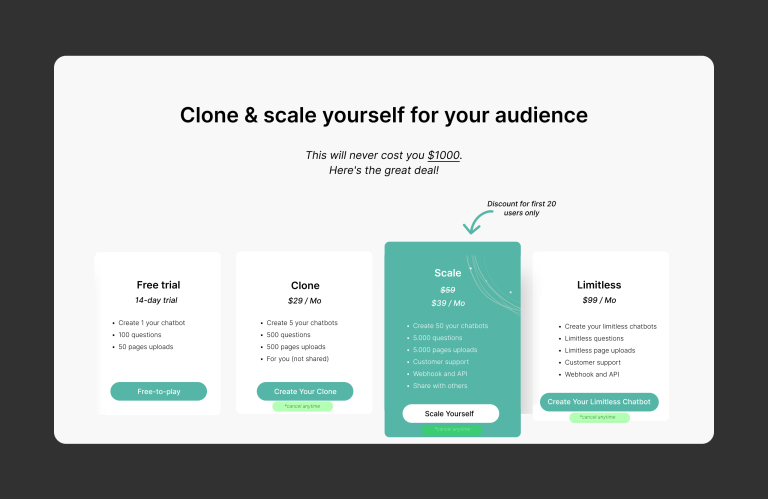
What if I buy the product and don’t like it?
I use the bottom of the buttons in Pricing to refute this.
You can get rid of me anytime you want :)
Lighten the Cognitive Load
Related cognitive biases and effects; choice overload, paradox of choice, decision fatigue
Cognitive load refers to the amount of mental effort required to process information in working memory. When a landing page has a high cognitive load, it can overwhelm visitors and make it difficult for them to absorb and understand the information presented. This can lead to frustration, confusion, and a higher likelihood of visitors abandoning the page without taking the desired action.
Lightening the cognitive load on a landing page is important because it can help to improve the user experience and increase the likelihood of visitors converting.
This can be achieved by simplifying the design and layout of the page, reducing the amount of text and visual elements, and ensuring that the content is easy to read and understand.
Everything we include on our landing page creates a cognitive load and a decision point. A potential customer’s brain constantly (unconsciously) asks: “Is this ok for me? Should I keep scrolling?”
If you don’t do these, the customer will be cognitively exhausted before they reach the decision-making stage. Be ruthless and remove anything unnecessary.
Show What Others Are Doing
Related cognitive biases and effects: Social proof, herd behavior
We are influenced by others. When we are indecisive, have no opinion, or want to confirm our decision, we tend to follow what others are doing (herd behavior).
If you walk in the opposite direction of everyone else at a subway exit, you will soon doubt yourself (“Am I going the wrong way?”).
On a landing page, showing how others have used and benefited from your product can serve as a guide for potential customers.
Here’s my Docuchat example:

I provide potential customers with public chatbots created by others. They can see how the system works and what it can do.
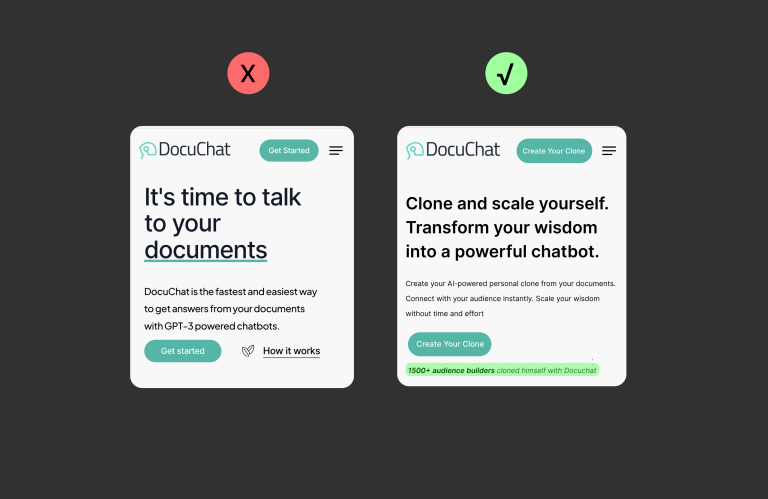
There are currently over 1500 users using the product. It would be more beneficial to mention this as social proof next to the button on the hero section.
By doing this, I am creating social proof, emphasizing emotional segmentation, and explaining the benefit of the product’s ability to clone itself.
Make Visible:
Associated cognitive biases and effects; Attention bias, salience bias
The most critical thing for conversion is the buttons we use. Therefore, we must make them visible.
The buttons in the middle sections seem insufficient. It is not eye-catching and visible enough. I am making it more visible.

Trigger / Prompts: Call to action for your potential customer
Define a Target Behavior
Each landing page should have only a target behavior.
Our target behavior for Docuchat is to convert a potential customer. The thing that will make this behavior happen is our buttons.
We should remove anything that does not directly or indirectly contribute to the target behavior. No confusion, no aimless guidance.
The entire page should be designed to serve the target behavior.
Create Urgency and Scarcity
We must trigger and motivate potential customers in a situation where we increase their desire and remove barriers.
We must convert a potential customer after increasing their desire. If they postpone it, their emotional connection will decrease or disappear. And the rational brain comes into play.
So why should they buy it now?
Yes, I think the product is great. But I can buy it later.
We must prevent potential customers from postponing it.
We can the solution this problem with scarcity and urgency.

I will discuss the pricing strategy in the next section, but I need to explain this principle now.
I am offering a discount for one of our packages, which is $39 instead of $59, but this is only valid for the first 20 users.
This is a scarcity offer, only available to 20 people, which creates urgency. I don’t want to miss out on this discount because the 20-person limit could be reached at any moment.
4. Create Irrational Pricing Strategy

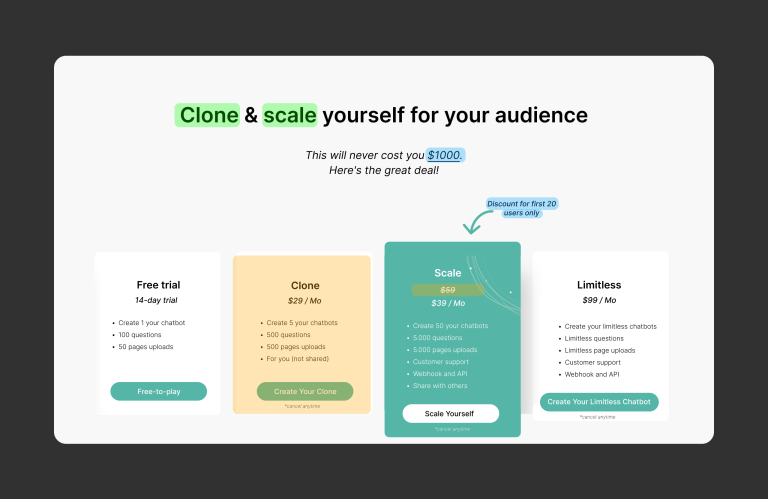
With this kind of pricing, which package would you choose?
Let me tell you. You will choose the Scale package. Because I designed this pricing hypothesis to make you choose the Scale package.
We will have the following distribution for paying users:
-About 15-20% will purchase the Clone package.
-About 70-80% will purchase the Scale package.
-About 5-10% will purchase the Limitless package.
The results I will obtain are not a surprise to me.
Because I designed this hypothesis to obtain these results.
I guide people’s decisions. And I can predict the results. This is libertarian paternalism.
Insight for SaaS;
As far as I have observed, the pricing strategy is the place where the least time is spent in a product process. I cannot accept this. This is a great opportunity to increase customer/revenue per invoice.
Uncertainty, cognitive load, and what I said about target behavior, do you remember?
These are the key elements of a pricing strategy.
Problem:
We see almost the same thing in every SaaS. Linear pricing, 20% discount for annual payments, etc.
Just because they do this doesn’t mean it’s the only system that works.
Like the default effect, most SaaS copies each other without thinking enough.
However, small touches can significantly increase your revenue percentage-wise.
There are around 15 commonly known pricing methods. And most of them should be avoided. For example; cost-based, linear, usage-based, etc.
Our only goal throughout the entire process is to explain the value of our product. While doing this, we must reduce their cognitive load.
People make choices between the presented options. Those who design the options influence decisions and behaviors.
Here’s how I did it:
When designing pricing hypotesis, we have only one goal.
To make potential customers feel like they’ve made a foolishly advantageous (profitable) deal.
I want it to act on a potential customer because it’s advantageous.
And after buying it should say.
– I won with an amazing deal.
I should feel butterflies in the stomachs of customers as a result of a happy deal.
For example, which package in this design makes you feel like you’ve made a foolishly advantageous deal.
Do you remember the design in the Loss Aversion section? We created contrast there. We showed the difference between doing things manually and doing them with Docuchat. And we made the difference feel by emphasizing the losses.
Now we’re reminding it. “This will never cost you $1000”
We create an anchor with $1000. And we make our desired prices for our product look reasonable.
This anchor tells us that we are using cognitive bias as pre-persuasion. Because we are always affected by anchors. We always see the first number given to us as an anchor and then evaluate what is offered based on it.
The second anchor I used in Pricing is the Clone package. The Clone package serves as an anchor to make the Scale package appear more advantageous. (Both in content and price.)
The advantages offered by the 2nd package are very few compared to the asking price.
However, with the 3rd package, the prices are very close.
And package 3 is much better in terms of the benefits it offers.
Without needing to do much analysis, the 3rd package turns out to be a great deal.
If it’s $59, its purpose is another anchor.
Here, I am offering discounts and incentives to potential customers. You can buy it for $39 instead of $59. (People love discounts, but shouldn’t be too excessive.)
Let’s limit the discount to 20 people to increase the potential customer’s desire. Because scarce things are more valuable. (Supply and demand relationship)
On the other hand, this scarcity we created will prevent potential customers from procrastinating. Because we want them to buy now, not later, and they can miss out on the limited discount for 20 people at any moment. However, people tend to avoid missing out on opportunities presented to them.
2022 © irrational.marketing – Created by Denizcan Sanlav.